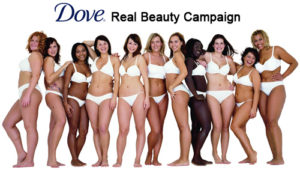Dove’s conceptual ad campaign of ‘Real Beauty’ since 2004 has been one of the most talked-about cases over the decades. Some celebrate it as an inspiring template for creating buzz and building an emotional connection with consumers, while some criticize it as abdicating responsibility and compromising power to manage what was said about the brand. At this point, should brand share control of the message with the public? Does such risk worth taking? What is at stake in such decision-making?
Opportunities
On the bright side, such move brings opportunities. The definition of ‘Real Beauty’ is such a broad concept that everyone can have their opinions and feel related to. It encourages people to challenge the traditional meaning of beauty and enrich it out of their own will. The topic itself touches a nerve with the public and can easily provoke a public conversation and debate that is so influential, and it actually generates a certain form of pop culture, which leads to massive media coverage for free. According to Harousseau, one of Unilever’s executives, that ‘you just can’t buy that kind of exposure. You can’t buy pop culture’ (Deighton, 2008, P5). Examined by the SUCCES model, this campaign is disruptive and unexpected, it tells real stories that get people emotional (Health & Health, 2007).
Besides, in response to the concern of the actual sales, Jennifer Bremner, brand director of skin cleansing at Unilever, clarified in an interview with HuffPost that ‘conversation leads to brand love, and brand love leads to brand loyalty, that’s obviously a positive for us not just in the power of the brand, but also ultimately in sales.’ (Bahadur, 2014). Brand association is rather significant and effective in driving sales, especially for such products that cannot physically change beauty in a direct way like cosmetics do, it is better to play in a conceptual way.
Threats
More attention brings more controversy and threats. Sharing the control of message with the public means that the public gets to change and question the message, which may potentially undermine the brand image. The public starts to question the authenticity of Unilever as, in addition to Dove, they have other brands selling diet products and advertising men’s body with sexist tropes about women. Jennifer Pozner, executive director of Women In Media & News, points out that ‘Dove’s message is at odds with its products, and that the company is capitalizing on women’s poor body images’ (Bahadur, 2014). The message itself arouses doubts. Although they give open definition to beauty, the emphasis is still on physical beauty. Such limitation is fatal to the real women empowerment. Furthermore, redefining the message not necessarily indicates that the people actually feel differently about themselves.
In addition, it does not only share control with the public, the potential consumers, but also potential competitors. There are more brands following the suit and capitalizing on the association of their products with the message of female empowerment, such as Pantene’s ‘Labels Against Women’ (Bahadur, 2014). The uniqueness is fading away and the Dove campaign is not as differentiated as it used to be.
How to navigate:
Looking deep into the design and execution of the ‘Real Beauty’ campaign, every seemingly random decision is made by strategies. Firstly, Deighton (2008) highlights that ‘the plan was grounded in research’ and ‘the global survey was the underpinning for all external communications’, which ‘lent scientific credibility to the hypothesis that the definition of beauty had become limiting and unattainable’ (P6). Secondly, it was not a temporary hit, they have strategically produced a series of ads over the years and those ads are becoming more and more inclusive: ‘Real Curves’ or ‘Tick Box’ in 2004, ‘Evolution’ followed by ‘Onslaught’ in 2007, ‘Pro Age’ in 2008, ‘Sketches’ in 2013 and ‘Selfie’ in 2014 (Neff, 2014). It tries to maintain the conversation and attention as well.
Thirdly, we can learn from the way they deal with parodies that, instead of eliminating, they embrace controversy. It is actually a smart move in navigating those conceptual issues. Last but not least, they ‘walk the talk’ by establishing the global Dove Self-Esteem Fund to raise the self-esteem of girls and young women and host a series of workshops to spread the knowledge and nurture the public (Deighton, 2008, P6). This is an essential move to make the message concrete and credible (Health & Health, 2007).
In conclusion, it can be concluded based on the discussion above that Dove is taking a risk, but in a systematic way; it does share control of the message to the public, but not all of it.
Reference:
Bahadur, N. (2014). Dove ‘Real Beauty’ Campaign Turns 10: How A Brand Tried To Change The Conversation About Female Beauty. [Online] Available at:http://www.huffingtonpost.com/2014/01/21/dove-real-beauty-campaign-turns-10_n_4575940.html
Deighton, J. (2008). Harvard Business Case: Dove: Evolution of a Brand http://cb.hbsp.harvard.edu/cbmp/access/58184481
Heath, C. & Heath, D. (2007). Made to stick: Why some ideas die and others survive. Random House. ISBN 10: 1400064287 https://www.amazon.com/Made-Stick-Ideas-Survive-Others-ebook/dp/B000N2HCKQ
Neff, J. (2014). Ten Years In, Dove’s ‘Real Beauty’ Seems to Be Aging Well. [Online] Available at:http://adage.com/article/news/ten-years-dove-s-real-beauty-aging/291216/





2 Responses to Should Brand Share Control of the Message with the Public?